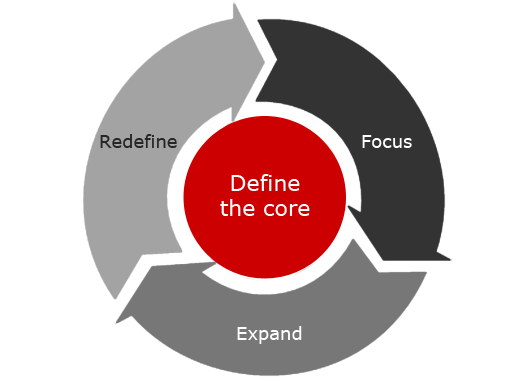The Situation
Polymer Company*, a leading manufacturer of plastics and other everyday chemicals, faced a number of challenges. Although its portfolio included a wide range of products, it did not lead in any segment. Management needed to identify which segments held the most attractive growth opportunities.
What was clear: the company was not focused on the critical market segments where it was most likely to win and was spreading its resources too thin. It also had let some of its core assets go underutilized, dragging down profitability. As a result, earnings and share price fell dramatically over the course of several years.
To get on firmer financial footing, the manufacturer had to develop a comprehensive transformation plan that addressed the obstacles to both its short- and long-term growth.
Our Approach
We collaborated with the CEO on a turnaround strategy that enabled the manufacturer to streamline operations and concentrate on its core businesses, using Bain's Profit from the Core approach. Key steps included:
Focus on business strengths: A detailed review of Polymer Company's petrochemical sourcing strategy revealed that the company was under-producing in the region that generated 100% of its profits due to supply shortages. As a near-term fix, we helped management sign new supply agreements in that region. With an eye to strengthening its long-term competitive position, we mapped out a more profitable product mix by conducting surveys to better understand customer needs, and then pinpointing other markets where Polymer Company could win. Our analysis of each business unit also identified a major under-performer and some divestiture opportunities.
Expand using a repeatable formula: We quickly developed a roadmap for mid-term expansion opportunities based on core markets. There were several areas where Polymer Company could outgrow larger competitors, but only with a focused approach. We picked the areas to pursue aggressively and also defined guidelines around the business. That plan, developed by modeling likely market growth and competitors' moves, was likely to yield more than $100 million over five to ten years.
Explore adjacency moves that anticipate redefining the core: For long-term growth, we mapped high-potential growth opportunities in adjacent areas. We led workshops to help management prioritize the options that offered the most strategic value.

Our Recommendations
We recommended that the CEO and board of directors adopt an end-to-end transformation strategy that included both immediate steps to boost profits as well as actions that would embed change throughout the organization for lasting results. The plan built on four major elements:
Improve core focus:
- Divest unprofitable business unit, freeing up resources to refocus on Polymer Company'score businesses;
- Increase profitability of regional assets with a detailed plan for raw materials sourcing. Secure low-cost petrochemical sources for its under-utilized but highest-margin region. Close an under-performing asset and locate more attractive feedstocks to reduce costs.
- Streamline the fragmented product mix and align products with markets where Polymer Company could establish itself as the segment leader. Better meet customer needs by changing offerings and investment priorities. Identify sales and pricing opportunities to outperform the market.
Implement mid-term expansion roadmap:
- Achieve market leadership in core market segments over five to ten years by increasing investments in key assets;
- Establish a clear decision-making process for executing investments;
- Implement new commercial management structure and reporting tools for long-term success.
Adopt a comprehensive growth plan that's both proactive and opportunistic:
- Evaluate additional growth opportunities using a criteria that looks at the value to core businesses, attractiveness, strategic fit and reasonable valuation;
- Consider a wide range of potential targets across six areas, including innovative and specialty products; acquiring technology and asset companies; launching new production facilities across the globe; and licensing other businesses.
Win over employees to the new strategy:
- Articulate a clear and consistent vision for the company;
- Redesign the commercial structure and processes to enable better focus;
- Celebrate successes and reinforce the desired behaviors to gradually change the culture and improve morale.
The Results
With a renewed focus on profiting from its core businesses, Polymer Company became a profit generator and segment leader in just two years. Earnings before interest increased as much as four times and the company's overall value shot up tenfold, reflecting a more efficient, focused organization that is poised to capture market opportunities.
There were results across the board:
- New commercial organization with clearly defined decision-making framework enables a rapid response to growth prospects and changing market conditions;
- Divestiture of a major, under-performing business unit removed a significant annual loss;
- Regional sourcing roadmap will bring assets to full capacity within three years;
- Streamlined product mix focuses on markets where the company can score strong wins;
- New sales and pricing tools close value gaps;
- Mid-term expansion plan positions company to achieve increased share in core market segments;
- Broader growth plan identifies potential targets with significant strategic value;
- Newfound trust between owners and management has resulted in a substantial capital commitment in mobilizing its growth strategy.

* We take our clients' confidentiality seriously. While we've changed their names, the results are real.

